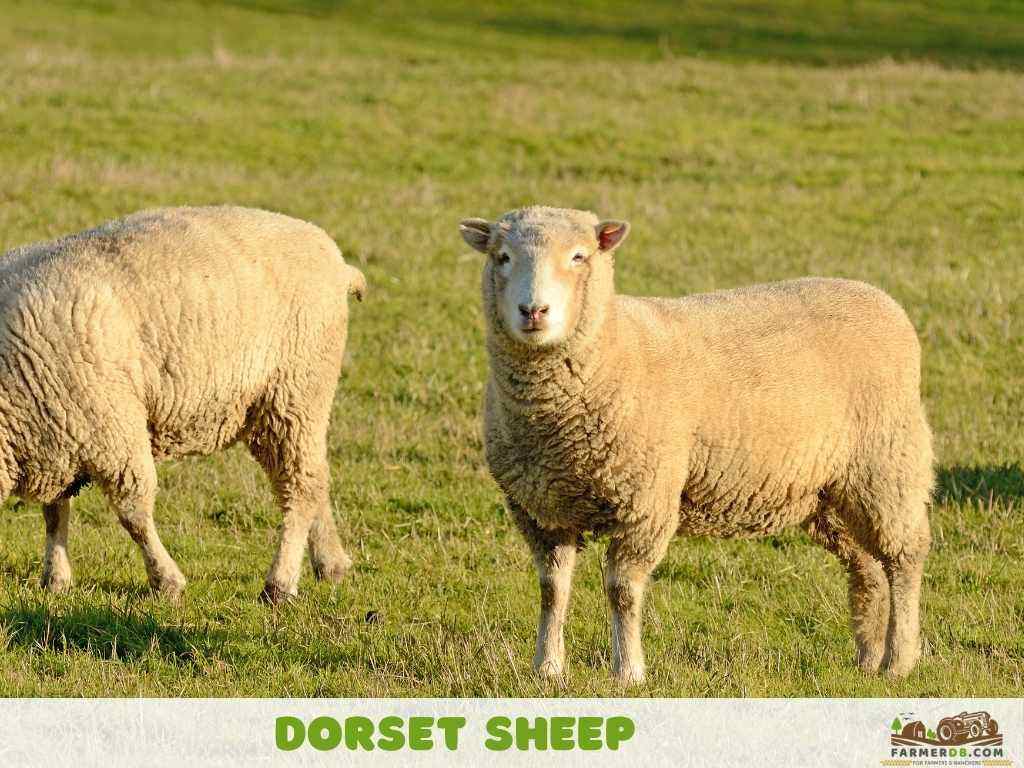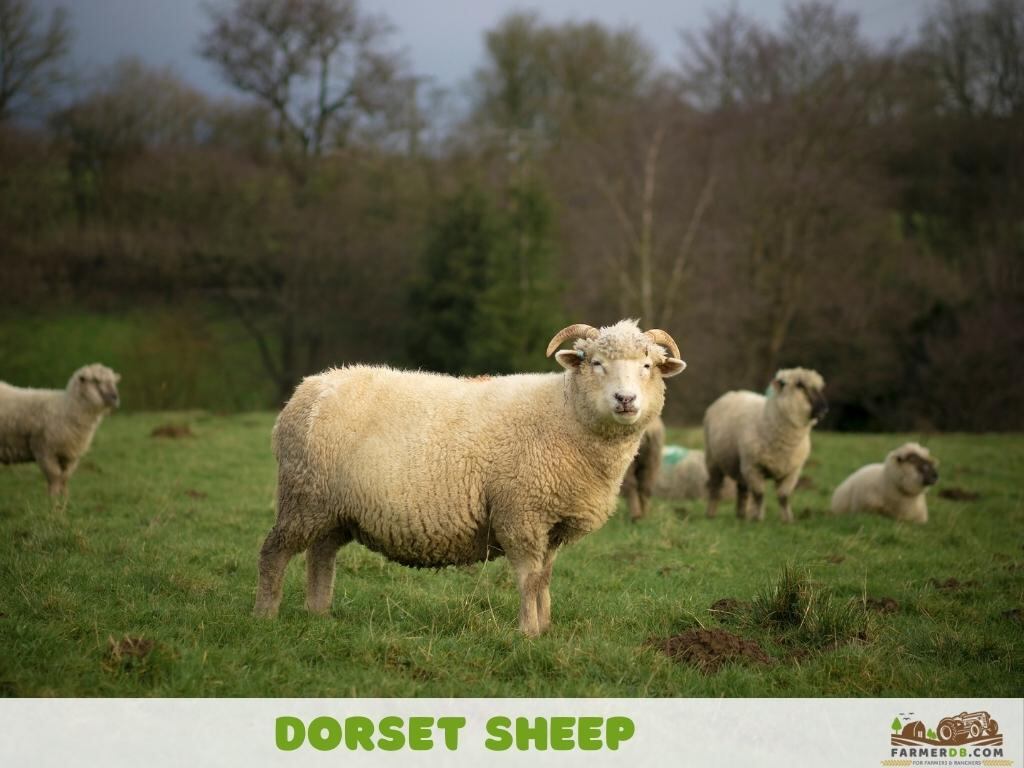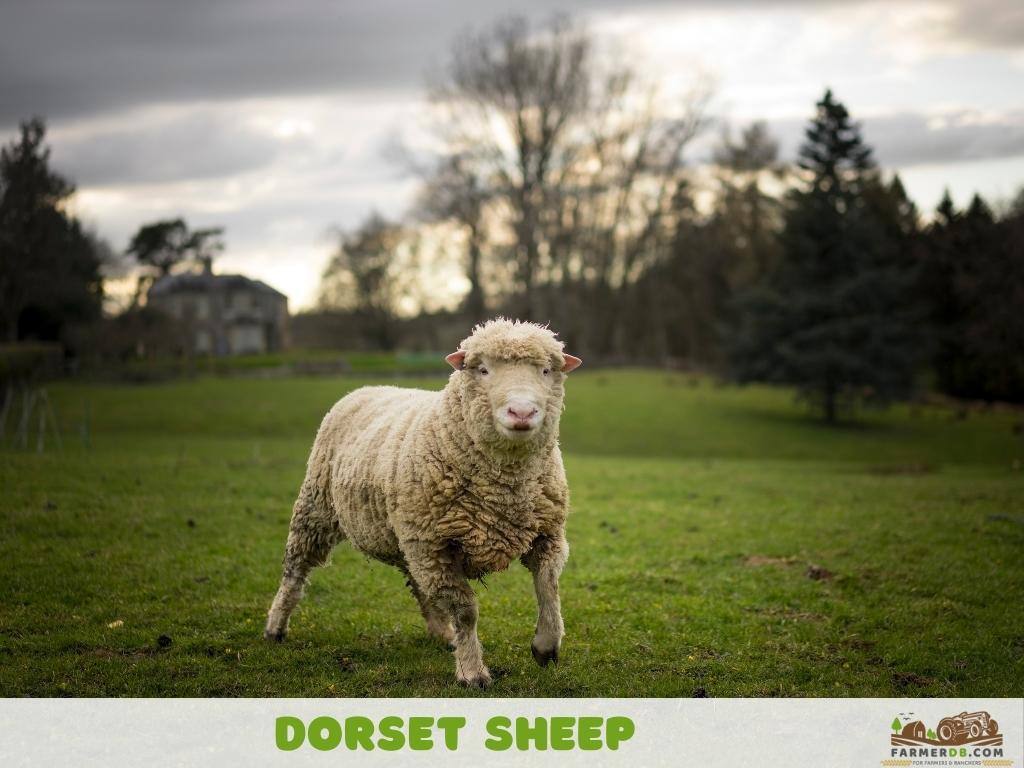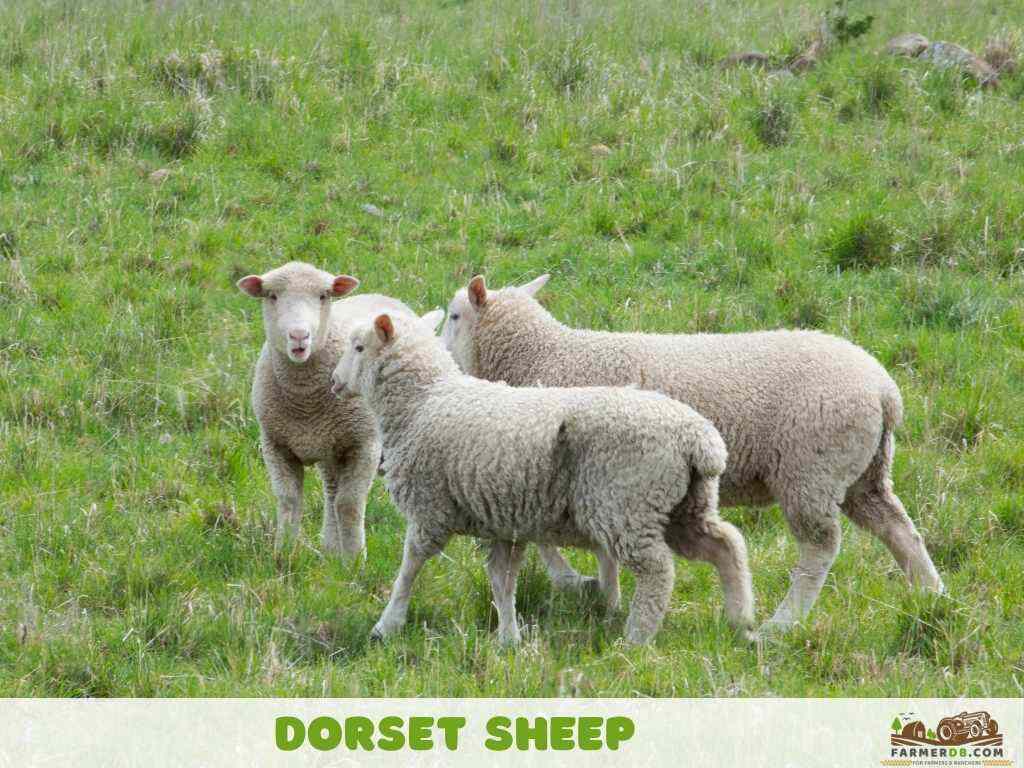Dorset is a threatened British breed of domestic meat sheep that is available in three different versions: Horned Dorset, Polled Dorset, and Dorset Down.
The distinction among these three types of Dorset lies in their appearance.
The horned Dorset has horns, while the Polled Dorset does not, making it a polled sheep. The third one, Dorset Down, has a colored face and legs.

Contents
Characteristics
Size
The Dorset sheep has a medium size.
In terms of dimensions, an adult Dorset sheep has a height ranging from 34 to 37 inches (86 to 93 cm) at the shoulder, and a length of 50 to 66 inches (127 to 167 cm), with the majority of the body length extending from the 13th rib back.
Color
They are entirely white.
Any presence of additional spot colors on the body disqualifies a Dorset sheep when registering it officially.
Skin and Fleece
The skin is smooth, without large wrinkles or loose folds, and is pink, soft, and visually appealing.
The fleece or wool is white, short, and medium-textured. It covers most of the sheep’s body, including the forehead and the sides of the head.
Head, Ears, Face, Eyes
The head is neat and well-proportioned to the rest of the body. It has wool on the top and under the jaw.
The face of this sheep has a good width and a medium-length muzzle. At the same time, it is smooth and open, with a pink nose, big nostrils, and a pink mouth.
The eyes are big and bright, while the ears are of medium size and covered with white wool
Horns
The horns of the pure-horned Dorset vary between ewes and rams.
The horns of the horned ewes are located in front of the small ears, curving forward and downward near the jaw.

The ram’s horns start in front of the ears, having a downward and forward spiral while avoiding any contact with the face or jaws. Their horns are heavier than the ones of the ewes.
As for those with partial or no horns, the tear ducts of the scurs are small or medium and not very prominent but covered in white hair.
At birth, ram lambs have “nubs” on the top of their heads, a trait not immediately visible in ewe lambs. However, ewe lambs will start developing these nubs a few days after being born.
Neck, Shoulders, Chest
These sheep have a well-proportioned and properly positioned neck, with the head held high and alert. The neck is of moderate length and doesn’t have any wrinkles or extra skin. The rams look more masculine in their necks because they also have a distinct crest.
The shoulders have a smooth, oblique structure, seamlessly integrating with the ribs.
The chest displays deep ribbing, a well-sprung form, and width reaching the chest floor.
Ribs
They have 13 pairs of ribs, totaling 26 ribs in all. This is a common characteristic among sheep breeds, including Valais Blacknose and Katahdin.
Back, Loin, and Rump
The sheep’s back is strong due to good musculature, presenting a straight and level profile that extends smoothly to the dock, resulting in a high position for the tail head.
The loin and the rump are also very strong, much like the back, and are long, wide, and deep.
Legs and Feet
With a very well-defined bone structure, the sheep’s legs are straight and robust, thanks to the substantial muscle in the forearm and rear leg areas.
The upper leg is adorned with a dense wool covering, and white hair extends below the wool area. The lower leg, below the hocks and knees, is covered in thick hair, featuring a moderate amount of wool, particularly on the front side.
As for the feet, these are aligned in a straight position with no deviation or turning angle. These sheep also have short and sturdy pasterns.
The most important Dorset sheep characteristics are the loin, rump, and legs. These three parts of the sheep must constitute 50% of the length in the hindsaddle.
Tail
The tail is short and in a line with the back.
It is very common among farmers to dock the tail when the lambs are very young for reasons such as hygiene, ease of management, or the prevention of feces accumulation or debris.
Lifespan
The lifespan of the Dorset sheep breed is 12 to 14 years.
Keep in mind that factors such as health, farm management practices, genetics, and food quality play an important role in life expectancy and can significantly influence their overall lifespan.
Growth Rate
How fast dothey grow?
Dorset sheep grow very fast, reaching a good carcass weight at 10 to 16 weeks of age.
They are known for their rapid growth, especially in the first few months of life, during which they can gain around 0.5 to 1 lb (0.23 to 0.45 kilograms) per day when provided with the right nutrition.
As for sexual maturity, they are ready for breeding at 7 to 9 months.
Weight
A sheep’s weight varies between 160 and 220 lbs (70-90 kg).
As with many other sheep types, such as Jacob sheep, the ewe is smaller than the ram. The ewe’s weight ranges from 160 to 180 lbs (70-82 kg), while the ram weighs between 200 and even 275 lbs (91-125 kg).
Slaughtered age
You can slaughter these sheep at 12 weeks of age when they weigh between 44 to 53 lbs (20 and 24 kg).
This presents a significant benefit for prime lamb producers, but if you aim to obtain a larger quantity of meat, you can always slaughter it later when it reaches a better weight.
Shearing
These sheep need to be sheared in the spring or early summer to keep them cool during the warmer months of summer. Most farmers choose to do it at the end of March and in April, but the timing also depends on the climate in your region.
Shearing before summer not only improves wool quality but also promotes the overall health of the sheep. It helps minimize the risk of parasites and enhances hygiene.
To shear a Dorset sheep properly, you need to have the right tools and follow some simple steps:
- Prepare: Ensure you have all the necessary tools within reach, including electric or manual shears, a comb, a brush, and a box or container to collect the wool.
- Position the Sheep: Make sure the sheep is in a comfortable position. This not only ensures the process is pleasant for the sheep but also makes it safer and easier for you. Keep in mind that the sheep should be steady during the shearing process.
- Analyze the Wool: Examine the sheep’s wool and identify any areas that require special attention or might risk contaminating the rest of the wool.
- Start Shearing: Begin shearing from the belly area, moving up to the sides, and then finishing with the back. Be extra careful not to harm the sheep’s skin; holding the shear correctly minimizes this risk.
- Handle Sensitive Areas with Care: Take extra care when shearing sensitive areas such as the udder, face, and around the genitals. Use smaller, more precise shears for these delicate areas.
- Clean Your Equipment: After finishing the shearing process, clean your equipment. Well-maintained tools contribute to a smoother shearing experience and help prevent injuries to both the sheep and the shearer.
Temperament and Behaviour
These sheep are docile animals with a calm and gentle temperament, making them ideal for novice farmers entering the sheep-raising business.
Thanks to their incredibly calm nature, they are easy to manage and require no prior experience. Tasks such as shearing, administering vaccines, and providing other treatments are straightforward. Managing their flock is also hassle-free.
They interact well with other sheep and are sociable with other animals.
This sheep breed displays good intelligence and can learn simple routines. This trait is especially useful, as rams tend to show aggression during mating periods. Training them from a young age increases the likelihood of them being less aggressive as adults.
Usage
Dorset sheep are used for meat, wool, skin, and milk.
Meat
The meat scores very high on the Lean Meat Yield (LMY) scale.
This is due to its genetics, as this sheep has great carcass quality in terms of the fat-to-muscle ratio as well as size. Some even say that the fat-to-muscle ratio of the carcass is ideal.
But the carcass is not all that these sheep have to offer in terms of meat. Their sizable loins and hindquarters are also very high-quality meat cuts appreciated by chefs.
The meat has an attractive red color, great tenderness, as well as taste.
Wool
The wool is dense with a fine texture, featuring fibers with an irregular crimp. It is free from kemp and resists matting. The high lanolin content, a natural oil produced by the sheep’s glands, enhances the wool’s softness and moisture resistance.
This is a medium wool with a staple length of 2½–5 inches (6.5–12.5 cm) and a fiber diameter of 26 to 33 microns.
A single sheep produces 4½–9 lbs (2–4 kg) of wool.
One of the standout qualities of their wool is its excellent elasticity, which makes it very easy to work with.
The traditional method for working with Dorset wool involves proper preparation and spinning, processes that enhance its insulating properties and warmth.
For increased durability and stitch definition, worsted preparation and spinning are excellent alternatives.
The wool is versatile and can be used to create a variety of projects, including sweaters, hats, blankets, and more.
Milk
Even though Dorset’s main usage is for meat and wool production, some choose to use these sheep for milk production too. They have large udders and are capable of producing a lot of milk for the lamb to feed them.
The milk has a high-fat content of 6.5%, which is closer to Suffolk sheep milk, and a protein content of 5.8%, scoring very high on the scale next to Romanov with 6.1%.
Skin
The sheepskin is used in leather production for footwear, gloves, accessories, and traditional crafts and artisanal products.
Raising
Raising this sheep breed is easy thanks to their good behavior and low maintenance. With proper food and a suitable environment, you’re all set.
Feeding
These sheep are good grazers and can spend up to seven hours daily in open fields, feeding themselves. However, if you do not have access to ample pasture or if your pasture lacks rich, fresh grass, you can feed them alfalfa hay or alfalfa pellets, as these have a high content of nutrients essential to sheep.
Another option is grains and other commercial feeds, but you must be careful not to feed them too much, as grains can cause bloating in sheep, which can be life-threatening.
You should supplement their daily diet with mineral supplements, such as salt licks. Additionally, ensure they always have access to fresh drinking water.
How many sheep per acre?
You can raise 7 to 10 sheep per acre.
Always guide yourself by the pasture quality, as this will influence the exact number of sheep you can raise per acre. If the pasture is rich in vegetation, then maybe you can add more than 10 sheep per acre.
The area you live in and its climate also influence the final numbers, as regions with frequent rainfall can sustain a higher number of sheep, while arid climates support fewer.

Another factor that influences the number of sheep per acre is the supplemental feed you offer. If you provide supplemental feed such as hay or grains, they will graze less, allowing for a higher number on the pasture.
Environment
They live in open environments like pastures, grasslands, and other types of vegetation lands. These sheep need the freedom to graze freely.
Climate
The right climate for them is a temperate one with moderate temperatures and rainfall that also sustains good, fresh pasture.
They are not well-suited to be raised in extremely hot or cold climates, as they will not develop properly and may face different health issues.
Shelter
This breed requires shelter that protects them from harsh weather and predators. The shelter doesn’t need to be sophisticated but should be practical.
For example, a simple barn with separate areas works well for isolating sick sheep to prevent the spread of illness or for housing pregnant ewes.
The most important features of the shelter are proper bedding to keep them warm during the rainy or cold season, along with good ventilation and lighting. In summer, the shelter also provides shade.
Additionally, you should install an electric fence to keep them secure. The fence should be at least 5 feet tall and free of gaps.
Breeding
Breeding can start around 7 to 9 months of age. However, I recommend waiting until they are 9 to 10 months old, as the ewes will be physically mature enough for pregnancy and lambing.
The breeding process is simple: just introduce the ewe to the ram, and they will naturally mate.

These sheep are highly fertile, capable of breeding year-round and lambing at various times. While this can be advantageous for those in business, it may present a significant challenge for smaller farmers with limited space.
To avoid unwanted pregnancies, you must separate the rams from the ewes.
Their gestation period lasts between 145 and 152 days.
Ewes typically do not need assistance during gestation, but you should prepare a separate space for them when they give birth.
Ewes have a strong maternal instinct and take excellent care of their lambs. They also produce plenty of milk, which is sufficient to feed the lambs during the early stages of life.
Health Issues
Some of the most common health issues include:
- Internal and external parasites. To avoid these issues, you need to deworm your sheep regularly and always monitor your pasture for parasites.
- Respiratory issues due to viruses or bacteria. This occurs when the shelters where they live lack proper ventilation or when hygiene is poor. Ensure their living space has adequate ventilation and is kept clean.
- Footrot
- Bloat. Proper management of diet and access to grazing can help prevent this condition.
- Mineral deficiencies
Why should you raise them?
Raising these sheep is a good idea, whether you’re in the sheep meat or wool business, or just a homesteader looking to have your own supply of sheep meat.
From a business standpoint, these sheep are valuable due to their well-muscled bodies, resulting in a substantial meat yield that can be sold for profit.
Compared to other sheep breeds, this breed has a high reproductive rate, allowing for year-round breeding. Their prolificacy, coupled with the fast growth of lambs, is advantageous for meat producers by reducing the time and resources needed to bring lambs to market.
For homesteaders, these sheep are a great choice, even for those without prior sheep-raising experience. As long as you provide a suitable grazing area, shelter, and fresh water, you can successfully raise them in your backyard.
Even though it can be a pricey investment, with the price for one of these sheep ranging from $500 to $650, it is totally worth it.
A and D
Advantages
- They produce high-quality meat.
- They can generate a sufficient amount of milk to feed the lambs.
- They exhibit excellent breeding capabilities, lambing multiple times throughout the year.
- They are low-maintenance.
- They are docile and easy to handle, making them ideal for beginners.
- They can be used for wool production.
Disadvantages
- They are not highly adaptable to different climates or environments.
- They require ample pasture space for grazing.
- They are relatively rare.
- Their feed intake can increase if they are bred twice in a year.
Other Facts
- Polled Dorset and Dorset Down are very rare.
- In North America, there are only white-faced Dorset sheep, specifically in types such as Dorset Horn and Poll Dorset, with the latter being the more common one.
- A Dorset sheep that has a mouth or nose with any colors other than pink or black is considered a highly undesirable trait.
History and Origins
The origins of this breed remain unclear due to a lack of documentation alongside history. Many years ago, when Spain aimed to conquer England, Merino sheep might have been brought to Southwest England. These sheep were likely crossed with the Horned Sheep of Wales, creating a versatile all-purpose breed that became widespread in Dorset, Somerset, Devon, and Wales.
This breed is known by a different name in the United States.
The sheep were first imported into the United States in the state of Oregon in 1860 from England, as stated by the Sheep Industry in the United States publication by Oregon pioneers Ezra Carmen, H. A. Heath, and John Minton.
In 1890, the Continental Sheep Club was created, the association that registered all sheep of this breed.
In the early 1950s, at North Carolina State University in Raleigh, North Carolina, a genetic mutation leading to polledness emerged in four lambs. Until that time, only horned varieties of this breed were recognized.
This event led to the creation of the Polled variety. Australia also saw the development of Polled sheep in the early 1900s, involving the crossbreeding of Corriedale and Ryeland into the horned variety.
In 1956, the Continental Sheep Club officially recorded the first Polled sheep, listing them in the same flock book as the horned varieties. The popularity of the polled variety has made this breed the second most favored sheep breed in the United States.
This breed has a worldwide conservation status of “not at risk,” but when looking closely at the country level, these sheep are listed as “vulnerable” in Australia, “priority” in New Zealand, and “threatened” in the United States.
Do you have any experience with the topic discussed here?
Would you like to improve the information shared and contribute your practical knowledge on the subject?
Your real-world experience as a farmer or rancher could greatly benefit other members, and the community would deeply appreciate your contribution.


Thank you for sharing the information about the Dorset breed of sheep. I do not have sheep as yet, still investigating what breed might be the most suitable for our needs, and the information has been most useful. I am only wanting sheep for personal supply, not commercial and thus far the Dorset appear to be the most appealing to me. Cheers
You’re welcome, Vonnie!
I’m glad you found the information helpful. Dorset sheep are indeed a versatile breed, well-suited for both wool and meat, and they can be a great choice for personal use due to their docile nature and reliable breeding cycle.
If you have any more questions or need further assistance as you continue your research, feel free to ask.
Good luck with your decision, and cheers!